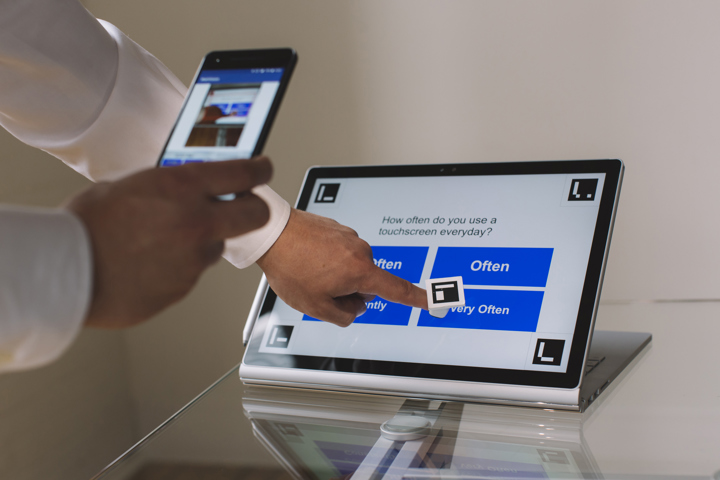From grocery self-checkouts to bank ATMs, touch screens are increasingly becoming an integral part of daily life and are seemingly user-friendly. However, touch screens require the user to see the text, buttons and pictures, making them inaccessible to the visually impaired population, which accounts for approximately half a million people in Canada.
University of Waterloo mechatronics engineering graduates Craig Loewen and Lior Lustgarten set out to solve this problem with their invention, WatVision, earning them the top prize in the Canadian leg of the 2018 James Dyson Award. WatVision combines three parts: a smartphone app, industry standard detection markers placed on each corner of a touchscreen and a ring worn on the users’ finger. The app first employs the smartphone’s camera to identify the position of the touch screen by locating the four detection markers that act as screen boundaries. It then takes an image of the touch screen, which is sent to Google Cloud and downloaded onto the phone. Once the user points to a button on the touch screen with the ring wearing finger, the app locates the ring and uses the downloaded image to read the text out loud, allowing the user to select the correct action and independently use the touch screen service.
For Loewen, Lustgarten and the WatVision team, accessibility issues were top of mind when researching ideas for their fourth year university engineering project. A blog post about how a visually impaired person couldn’t use their new office touch screen coffee machine inspired the team to design something that truly makes a difference for this community. Lior Lustgarten, team leader, WatVision said: “Once we realized how much we used touch screens on a daily basis and how it would not only affect visually impaired people, but the aging population, we knew we could make a large impact on an underdeveloped market. After interviewing members of this community, it was apparent that this was an overlooked problem that needed a solution.”
Following the ideation of the design, it took eight months and six iterative software designs to fully develop WatVision as the team prioritized making the design natural and user-friendly for visually impaired people. Once the project was complete, the team decided to make WatVision open source under the MIT license and allow access for others to make improvements and upgrades.
Craig Loewen, team leader, WatVision said:
“We are planning to continue working on WatVision as we move into our new careers after graduation. With the design being open source, we are hoping it will attract the attention of other engineers and people in technology who care about the same accessibility issues and can help improve the design.”
The team hopes to integrate images and colours into the next version of WatVision and for users to navigate the touch screen without wearing a ring. They will use the $3,000 James Dyson Award prize money to maintain server access subscriptions and computing time.
Lior added:
“We want our work to be useful to the people who live the need and hope WatVision becomes a valuable tool that can help change someone’s life.”
WatVision and the two national runners up, Printem and Revertome, will move onto the next stage of the James Dyson Award where a panel of Dyson engineers will select a top 20 international shortlist.
The Runners Up
Printem
Perumal Varun Chadalavada and Gowtham Ramachandran, University of Toronto
Problem: Designers and engineers usually have weeklong wait times between sending a printed circuit board (PCB) design for fabrication and receiving a prototype to test.
Solution: Printem is a “smart film” that lets users go from design to physical circuit in 3 minutes—all by using home-office printers. Printem is a multilayer stack of different photosensitive materials that work together to create a final copper circuit pattern. The printer film first creates a photo-mask, which only lets light through in sections where the ink is absent. When the film is exposed to light, the light penetrates the layers of the material and initiates a reaction that selectively sticks the copper to the substrate. When the user peels the film, the copper tears in exactly the right pattern to create the final circuit.
Revertome
Richard Cheng, Sijin He, Gertraud Eylert, Yizhou Gao, Hasan Ahmad, Navid Hakimi and Jean-Michel Gariepy, University of Toronto
Problem: Current industry practices to treat burn injuries involves the use of a dermatome to isolate healthy skin to create meshed grafts, but this leads to the doubling of the injured area which may lead to additional infection.
Solution: Revertome is a surgical instrument that delivers cells in a bioink via a compact handheld bioprinter to treat severe burns. The modular design of the printhead allows sterile and consistent deposition of biological materials over large physiological surfaces.



Share this page on